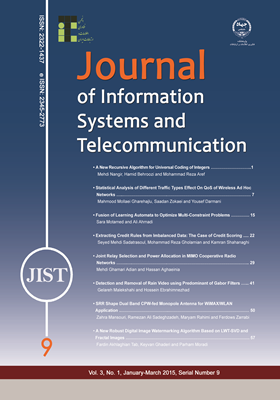-
-
List of Articles
-
Open Access Article
1 - A New Recursive Algorithm for Universal Coding of Integers
Mehdi Nangir Hamid Behroozi Mohammad Reza Aref -
Open Access Article
2 - Statistical Analysis of Different Traffic Types Effect on QoS of Wireless Ad Hoc Networks
Mahmood Mollaei Gharehajlu Saadan Zokaei Yousef Darmani -
Open Access Article
3 - Fusion of Learning Automata to Optimize Multi-constraint Problem
Sara Motamed Ali Ahmadi -
Open Access Article
4 - Extracting Credit Rules from Imbalanced Data: The Case of an Iranian Export Development Bank
Seyed Mahdi Sadatrasoul mohammadreza gholamian Kamran shahanaghi -
Open Access Article
5 - Joint Relay Selection and Power Allocation in MIMO Cooperative Cognitive Radio Networks
Mehdi Ghamari Adian Hassan Aghaeenia -
Open Access Article
6 - Detection and Removal of Rain from Video Using Predominant Direction of Gabor Filters
Gelareh Malekshahi Hossein Ebrahimnezhad -
Open Access Article
7 - SRR shape dual band CPW-fed monopole antenna for WiMAX / WLAN applications
Zahra Mansouri Ramezan Ali Sadeghzadeh Maryam Rahimi Ferdows Zarrabi -
Open Access Article
8 - A New Robust Digital Image Watermarking Algorithm Based on LWT-SVD and Fractal Images
Fardin Akhlaghian Tab Kayvan Ghaderi Parham Moradi
-
The rights to this website are owned by the Raimag Press Management System.
Copyright © 2017-2025







